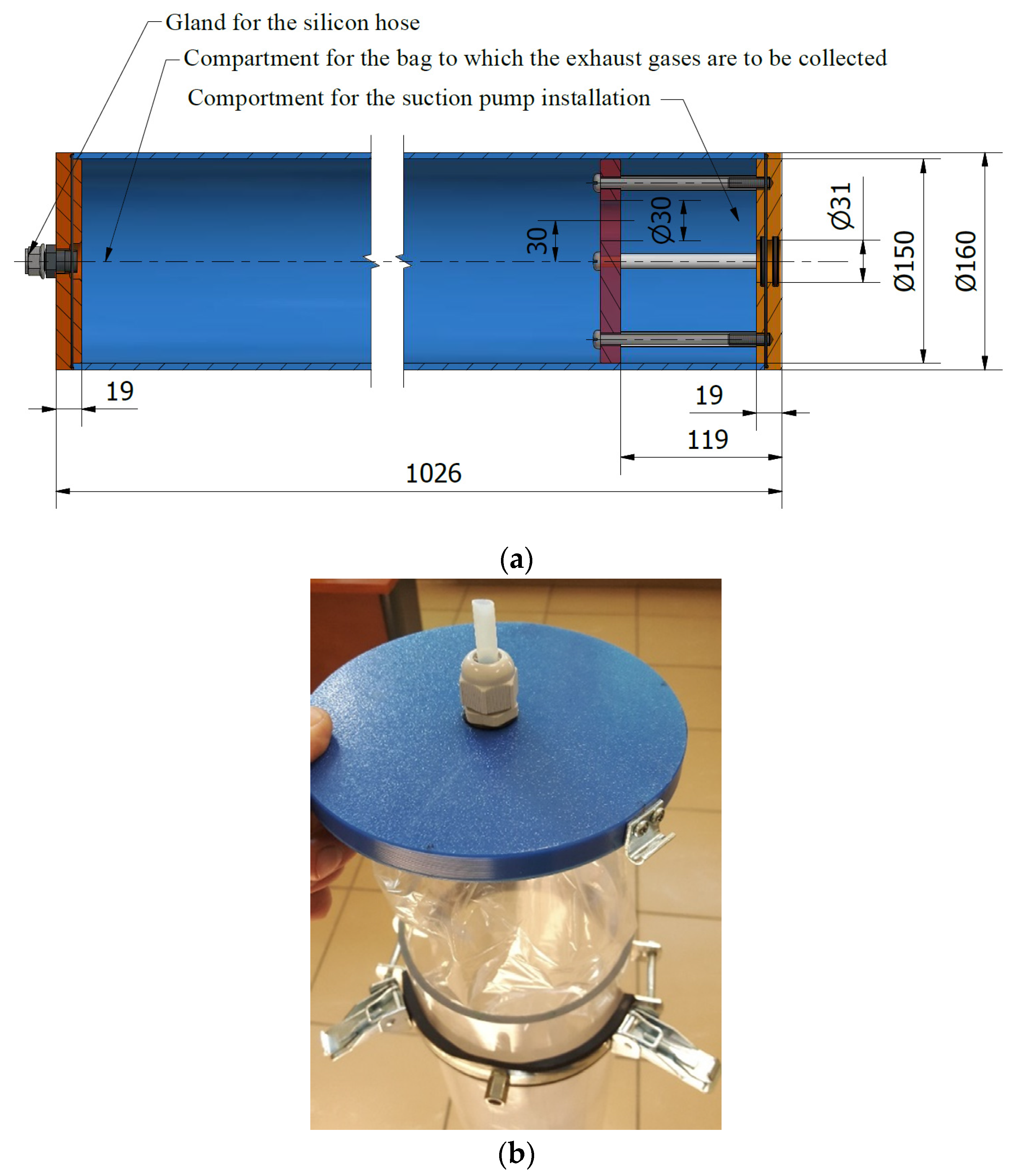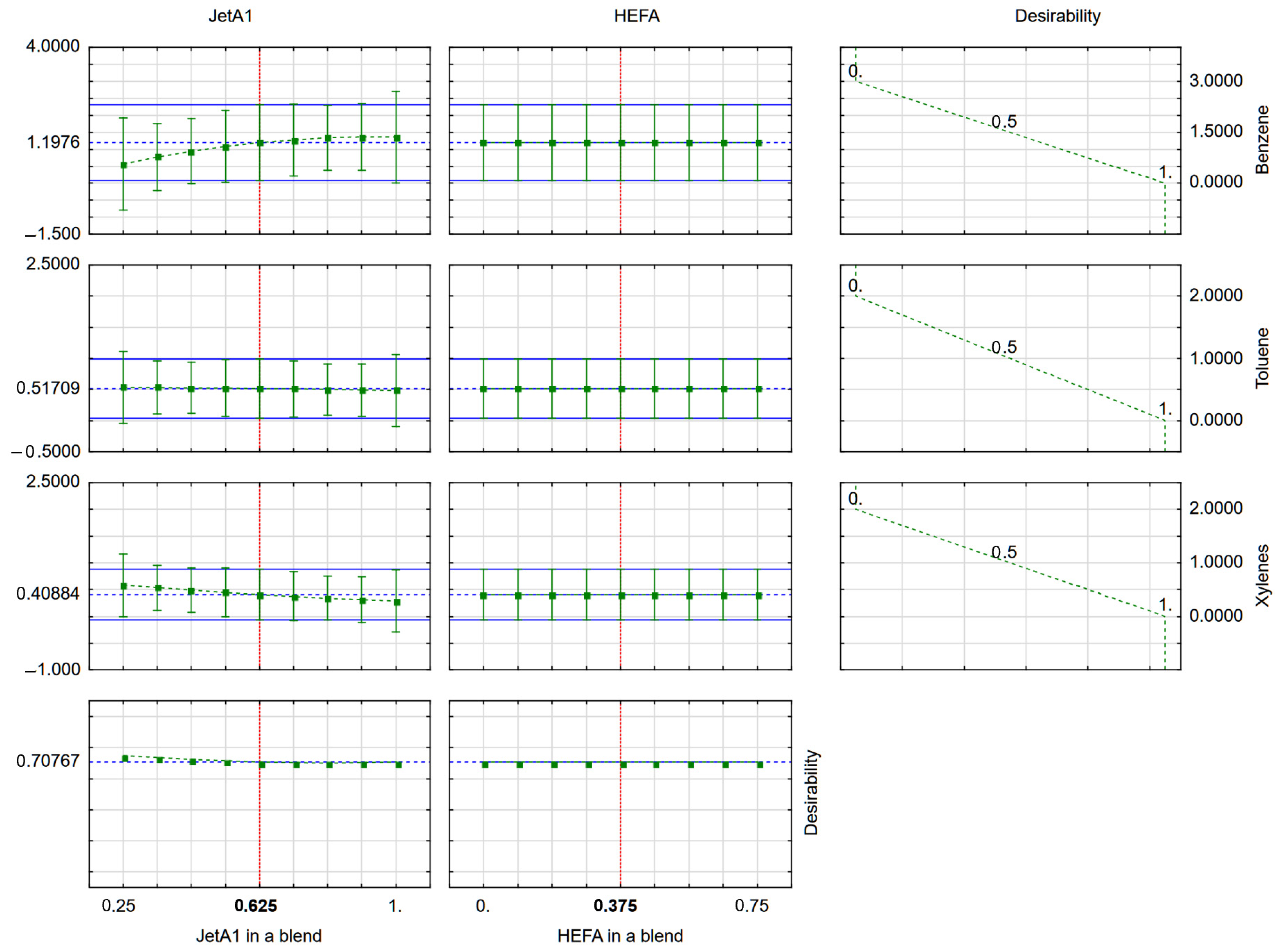Impact of a Synthetic Component on the Emission of Volatile Organic Compounds during the Combustion Process in a Miniature Turbine Engine
Abstract
:1. Introduction
- aliphatic hydrocarbons (e.g., ethane, ethylene);
- ring hydrocarbons (cycloalkanes);
- aromatic hydrocarbons (e.g., benzene, toluene, xylenes);
- halogenated hydrocarbons (e.g., chloromethane);
- nitrated hydrocarbons (e.g., nitrobenzene);
- alcohols and phenols (e.g., methanol, ethanol);
- carbonyl derivatives (e.g., acrolein, acetone);
- carboxylic acids and esters (e.g., formic acid, acetic acid);
- heterocyclic organic compounds containing inter alia nitrogen, oxygen, sulphur;most of them are the so-called odours,
- aliphatic sulphur compounds (odours);
- aliphatic amines (odours);
- aromatic amines (e.g., aniline).
2. Materials and Methods
- pure Jet A-1 fuel—Jet designation;
- blends of Jet A-1 with a HEFA technology component (used cooking oil feedstock) in concentrations of: 25%, 50%, 75% share (v/v) of the biocomponent—designation JetX/HEFAX, where X stands for the specific concentration of the given component.
3. Results and Discussion
4. Conclusions
- The use of a miniature turbine jet engine for testing the exhaust gas composition, including the assessment of volatile organic compound emissions, gives great benefits related to the possibility of planning much wider tests than in the case of full-scale turbine engine tests.
- In the performance analysis of the miniature jet engine, no significant differences were observed for all test fuels. After reaching the predetermined speed, the engine powered by different fuels generated similar thrust and temperature behind the turbine.
- As regards the emissions of volatile organic compounds in exhaust gases, the focus was on the most harmful compounds—the BTX group (benzene, toluene and xylene). Among this group of compounds, the highest concentrations were recorded for benzene.
- As the proportion of HEFA component in the blend increases, the concentration of benzene shows a decreasing trend, while the concentration of toluene and xylenes does not show an unequivocal tendency.
- The developed utility profile indicates that the most optimal, i.e., the least toxic in terms of exhaust gases (minimising the BTX concentration) is a blend with a share (v/v) of 62.5% fossil fuel and 37.5% of HEFA component.
- The next stage of research, planned for the near future, involves testing alternative fuels with regards to VOC emissions using a miniature jet engine at several engine operating modes, i.e., several rotational speed ranges.
Author Contributions
Funding
Institutional Review Board Statement
Informed Consent Statement
Data Availability Statement
Acknowledgments
Conflicts of Interest
References
- ASTM D7566. Standard Specification for Aviation Turbine Fuel Containing Synthesized Hydrocarbons; ASTM International: West Conshohocken, PA, USA, 2019. [Google Scholar]
- Dyrektywa 2004/42/We Parlamentu Europejskiego I Rady Z Dn. W Sprawie Ograniczeń Emisji Lotnych ZwiąZków Organicznych W Wyniku Stosowania Rozpuszczalników Organicznych W Niektórych Farbach I Lakierach Oraz W Preparatach Do Odnawiania Pojazdów. Available online: https://eur-lex.europa.eu/legal-content/PL/TXT/PDF/?uri=CELEX:32004L0042&from=PT (accessed on 21 April 2004).
- Kęska, A.; Janicka, A. Determination of volatile organic compounds for combustion engines compliant with Euro 4 and Euro 6. Proc. ECOpole 2017, 11, 387–394. [Google Scholar]
- Lebrecht, G.; Czerczak, S.; Szymczak, W. Benzen. Dokumentacja proponowanych wartości dopuszczalnych poziomów narażenia zawodowego. Podstawy Metod. Oceny Sr. Pr. 2003, 1, 5–60. [Google Scholar]
- Kruczyński, S.W.; Merkisz, J.; Ślęzak, M. Zanieczyszczenie Powietrza Spalinami Przez Transport Samochodowy; Wydawnictwo Komunikacji i Łączności: Warsaw, Poland, 2019; pp. 1–515. [Google Scholar]
- Herndon, S.C.; Wood, E.C.; Northway, M.J.; Miake-Lye, R.; Thornhill, L.; Beyersdorf, A.; Anderson, B.E.; Dowlin, R.; Dodds, W.; Knighton, W.B. Aircraft hydrocarbon emissions at Oakland International Airport. Environ. Sci. Technol. 2009, 43, 1730–1736. [Google Scholar] [CrossRef] [PubMed]
- Beyersdorf, A.J.; Thornhill, K.L.; Winstead, E.L.; Ziemba, L.D.; Blake, D.R.; Timko, M.T.; Anderson, B.E. Power-dependent speciation of volatile organic compounds in aircraft exhaust. Atmos. Environ. 2012, 61, 275–282. [Google Scholar] [CrossRef] [Green Version]
- Williams, P.I.; Allan, J.D.; Lobo, P.; Coe, H.; Christie, S.; Wilson, C.; Hagen, D.; Whitefield, P.; Raper, D.; Rye, L. Impact of Alternative Fuels on Emissions Characteristics of a Gas Turbine Engine—Part 2: Volatile and Semivolatile Particulate Matter Emissions. Environ. Sci. Technol. 2012, 46, 10812–10819. [Google Scholar] [CrossRef] [PubMed]
- Cross, E.S.; Hunter, J.F.; Carrasquillo, A.J.; Franklin, J.P.; Herndon, S.C.; Jayne, J.T.; Worsnop, D.R.; Miake-Lye, R.C.; Kroll, J.H. Online measurements of the emissions of intermediate-volatility and semi-volatile organic compounds from aircraft. Atmos. Chem. Phys. 2013, 13, 7845–7858. [Google Scholar] [CrossRef] [Green Version]
- Andoga, R.; Főző, L.; Schrötter, M.; Szabo, S. The Use of Ethanol as an Alternative Fuel for Small Turbojet Engines. Sustainability 2021, 13, 2541. [Google Scholar] [CrossRef]
- Boomadevi, P.; Paulson, V.; Samlal, S.; Varatharajan, M.; Sekar, M.; Alsehli, M.; Elfasakhany, A.; Tola, S. Impact of microalgae biofuel on microgas turbine aviation engine: A combustion and emission study. Fuel 2021, 302, 121155. [Google Scholar] [CrossRef]
- Suchocki, T.; Witanowski, L.; Lampart, P.; Kazimierski, P.; Januszewicz, K.; Gawron, B. Experimental investigation of performance and emission characteristics of a miniature gas turbine supplied by blends of kerosene and waste tyre pyrolysis oil. Energy 2021, 215, 119125. [Google Scholar] [CrossRef]
- Manigandana, S.; Atabani, A.E.; Ponnusamy, V.K.; Gunasekar, P. Impact of additives in Jet-A fuel blends on combustion, emission and exergetic analysis using a micro-gas turbine engine. Fuel 2020, 276, 118104. [Google Scholar] [CrossRef]
- Janicka, A.; Zawiślak, M.; Zaczyńska, E.; Czarny, A.; Górniak, A.; Gawron, B.; Białecki, T. Exhausts toxicity investigation of turbojet engine, fed with conventional and biofuel, performed with aid of BAT-CELL method. Toxicol. Lett. 2017, 280 (Suppl. S1), S202. [Google Scholar] [CrossRef]
- Gawron, B.; Białecki, T.; Górniak, A.; Janicka, A.; Zawiślak, M. An innovative method for exhaust gases toxicity evaluation in the miniature turbojet engine. Aircr. Eng. Aerosp. 2017, 89, 757–763. [Google Scholar] [CrossRef]
- Gawron, B.; Białecki, T.; Janicka, A.; Zawiślak, M.; Górniak, A. Exhaust toxicity evaluation in a gas turbine engine fueled by aviation fuel containing synthesized hydrocarbons. Aircr. Eng. Aerosp. 2020, 92, 60–66. [Google Scholar] [CrossRef]
- Janicka, A.; Zawiślak, M.; Gawron, B.; Górniak, A.; Białecki, T. Emission of volatile organic compounds during combustion process in a miniature turbojet engine. Environ. Prot. Eng. 2018, 44, 57–67. [Google Scholar] [CrossRef]
- Gawron, B.; Białecki, T. The laboratory test rig with miniature jet engine to research aviation fuels combustion process. J. Konbin 2015, 36, 79–90. [Google Scholar] [CrossRef] [Green Version]
- Gawron, B.; Białecki, T. Measurement of exhaust gas emissions from miniature turbojet engine. Combust. Engines 2016, 167, 58–63. [Google Scholar] [CrossRef]
- Białecki, T.; Dzięgielewski, W.; Kowalski, M.; Kulczycki, A. Reactivity Model as a Tool to Compare the Combustion Process in Aviation Turbine Engines Powered by Synthetic Fuels. Energies 2021, 14, 6302. [Google Scholar] [CrossRef]
- Gawron, B.; Białecki, T. Impact of a Jet A-1/HEFA blend on the performance and emission characteristics of a miniature turbojet engine. Int. J. Environ. Sci. Technol. 2018, 15, 1501–1508. [Google Scholar] [CrossRef]
- Gawron, B.; Białecki, T.; Janicka, A.; Suchocki, T. Combustion and emissions characteristics of the turbine engine fueled with HEFA blends from different feedstocks. Energies 2020, 13, 1277. [Google Scholar] [CrossRef] [Green Version]
- Przysowa, R.; Gawron, B.; Białecki, T.; Łęgowik, A.; Merkisz, J.; Jasiński, R. Performance and emissions of a microturbine and turbofan powered by alternative fuels. Aerospace 2021, 8, 25. [Google Scholar] [CrossRef]
- International Standards and Recommended Practice. Annex 16 Vol II, Environmental Protection-Volume II Aircraft Engine Emissions; International Civil Aviation Organization (ICAO): Montreal, QC, Canada, 2017. [Google Scholar]
- PKN. Powietrze Wnętrz, Atmosferyczne i na Stanowiskach Pracy—Pobieranie Próbek I Analiza Lotnych ZwiąZków Organicznych Z Wykorzystaniem Rurki Sorpcyjnej/Desorpcji Termicznej/Kapilarnej Chromatografii Gazowej-Część 1: Aspiracyjne Pobieranie Próbek; PN-EN ISO16017-1:2006; PKN: Warszawa, Poland, 2006. [Google Scholar]
- Białecki, T.; Gawron, B.; Giemza, B.; Głąb, J. Influence of synthetic fuel on nitrile rubbers used in aviation. Transp. Probl. 2020, 15, 29–41. [Google Scholar] [CrossRef]
- Sroka, Z.J.; Ahmed, H.; Sitnik, L.; Górniak, A.; Skrętowicz, M.D.; Magdziak-Tokłowicz, M. Prediction of Ternary Gasoline Composition Using Light and Heavy Alcohols to Reduce Fuel Consumption and Meet Emission Standards. SAE Tech. Pap. 2020, 1, 1–13. [Google Scholar]





| Parameters | Descriptions |
|---|---|
| type of engine | Turbojet—single spool |
| compressor | single stage radial compressor |
| combustion chamber | annular combustion chamber |
| turbine | single stage axial flow turbine |
| rpm | 33,000–120,000 |
| max. thrust | 140 N |
| fuel consumption at max. rpm | 420 g/min |
| mass flow at max. rpm | 350 g/s |
| max. exhaust gas temperature | 750 °C |
| Lp. | Property Name | Unit of Measurement | Testing Method | Jet | Jet75/ HEFA25 | Jet50/ HEFA50 | Jet25/ HEFA75 | HEFA |
|---|---|---|---|---|---|---|---|---|
| 1. | Density at 15 °C | kg/m3 | ASTM D 4052 | 789.3 | 779.8 | 770.7 | 761.4 | 751.9 |
| 2. | Viscosity at −20 °C | mm2/s | ASTM D 445 | 2.998 | 3.227 | 3.481 | 3.754 | 4.077 |
| 3. | Net heat of combustion | MJ/kg | ASTM D 3338 | 43.312 | 43.542 | 43.741 | 43.948 | 44.172 |
| 4. | Aromatics | % (v/v) | ASTM D 1319 | 15.1 | 11.0 | 7.2 | 4.0 | 0 |
| Fuel | Rotational Speed [rpm] | Engine Thrust [N] | Temperature behind the Turbine [°C] |
|---|---|---|---|
| Jet | 62,148 | 40.6 | 510 |
| Jet75/HEFA25 | 62,075 | 40.6 | 509 |
| Jet50/HEFA50 | 62,658 | 42.7 | 508 |
| Jet25/HEFA75 | 62,730 | 41.3 | 509 |
Publisher’s Note: MDPI stays neutral with regard to jurisdictional claims in published maps and institutional affiliations. |
© 2021 by the authors. Licensee MDPI, Basel, Switzerland. This article is an open access article distributed under the terms and conditions of the Creative Commons Attribution (CC BY) license (https://creativecommons.org/licenses/by/4.0/).
Share and Cite
Gawron, B.; Górniak, A.; Białecki, T.; Janicka, A.; Włostowski, R.; Włóka, A.; Molska, J.; Zawiślak, M. Impact of a Synthetic Component on the Emission of Volatile Organic Compounds during the Combustion Process in a Miniature Turbine Engine. Energies 2021, 14, 8462. https://doi.org/10.3390/en14248462
Gawron B, Górniak A, Białecki T, Janicka A, Włostowski R, Włóka A, Molska J, Zawiślak M. Impact of a Synthetic Component on the Emission of Volatile Organic Compounds during the Combustion Process in a Miniature Turbine Engine. Energies. 2021; 14(24):8462. https://doi.org/10.3390/en14248462
Chicago/Turabian StyleGawron, Bartosz, Aleksander Górniak, Tomasz Białecki, Anna Janicka, Radosław Włostowski, Adriana Włóka, Justyna Molska, and Maciej Zawiślak. 2021. "Impact of a Synthetic Component on the Emission of Volatile Organic Compounds during the Combustion Process in a Miniature Turbine Engine" Energies 14, no. 24: 8462. https://doi.org/10.3390/en14248462







